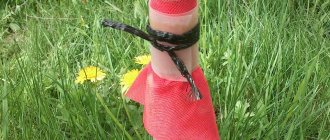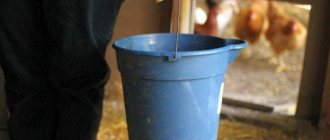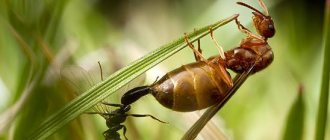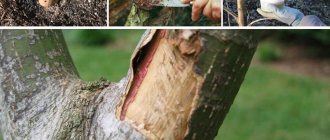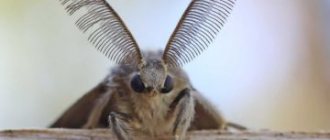If you want to protect your apple, pear or cherry tree from moths, leaf rollers, weevils and ants, you should use a trapping belt. These simple and effective traps will help get rid of uninvited guests once and for all.
Hot summers contribute to the appearance of a large number of pests. Fruit trees are especially affected by this. Most insects and other parasites climb the trunks to the most delicious parts of the trees - leaves, flowers, and subsequently to the fruits. Is it possible to stop pests at the stage of “marching” to the crown of the tree? Yes, especially if you use such a simple tool as a hunting belt.
What is a hunting belt and from whom does it protect the tree?
A catch belt is a trap that is widely used for mechanical control of garden pests. Usually it looks like a strip 20-25 cm wide, made of cardboard, paper, rags, straw, plastic film, burlap or rubber.
Hunting belts can be used on trunks of any diameter
Trapping belts are especially effective against pests that first descend to the ground to pupate and then climb up the trunk in search of food. These include:
- whiteflies;
- weevils;
- caterpillars;
- mites;
- aphids;
- bukarki;
- geese;
- apple flower beetles.
How to make an ant trap with your own hands
To make a dry belt, you will need to take a strip (rubber, corrugated paper or coarse fabric) about 20 cm wide. The length of the product will depend on the thickness of the fruit tree. Before you begin tying, seal all existing cracks. When making a dry ant hunting belt, you should consider the following:
- It is recommended to use stretch film for wrapping, especially if the wind is blowing. Unlike tape, it will not stick to the surface.
- Corrugated cardboard is best for use in the fall. This way you can protect the fruit tree from pests looking for a secluded place to settle down for the winter or lay offspring.
- It is recommended not to use cardboard on warm days.
To make a dry insect trap belt, you will need foam rubber, stretch film, scissors and a knife. How to properly wrap a fruit tree:
- To begin, prepare the foam rubber by measuring the material with a certain margin so that the edges can be joined to the trunk not butt-to-butt.
- Wrap the foam several times using stretch film. Two or three turns should be enough.
- Take a roll of film and wrap the foam rubber not too tightly. This is necessary in order to remove the gap at the junction of the edges. Make three or four turns.
- The tape must be cut and carefully smoothed to the belt. After this, use a sharp knife to remove the excess part above the belt in the lower and upper parts. This way the tree will look more neat, and the bark will be freed from excess insulation.
- Check the trap on each fruit tree about once a week. In order not to upset the balance, carefully remove the belt and scatter beneficial insects onto the newspaper, then wait until they crawl away on their own.
- 3 pension supplements that not everyone knows about
- Magnetic plasticine
- How to make a smokehouse with your own hands
Advantages and disadvantages of hunting belts
The trapping belt has several obvious advantages over other pest control products:
- This is an environmentally friendly trap, absolutely safe for trees and humans;
- with the help of a catching belt you can catch most of the pests (they cannot “bypass” the trap and inevitably fall into it);
- You can buy a ready-made version or make a simple hunting belt yourself.
Trapping belts can only be used on small areas where it is impractical to use chemicals
One of the main disadvantages of the trapping belt is that beneficial insects - ladybugs, bees, bumblebees, etc. - periodically get into it.
Gate trap for ants
Making a collar belt is as easy as making a funnel. The trap remains almost invisible on the trunk and, moreover, it is able to “transform” along with the tree. How to make an ant trap in the form of a collar - detailed instructions:
- Cut a rubber tape 4-5 mm thick and measure about half a meter from the ground level.
- Bend the edges and secure the tape to the trunk - you will get a kind of “collar”. Then glue the ends of the strip together with glue.
- Add sunflower oil to the resulting sealed container. Pests that get into the container will not be able to get out of it and continue moving down.
- The resulting elastic trap against ants and other insects will grow along with the tree. It can last a long time, the most important thing is to promptly remove any bugs that get into it and add vegetable oil.
Types of hunting belts and tips for making them
There are several types of hunting belts. They all have their own advantages and disadvantages that must be taken into account when making them. Currently, dry, poisonous and sticky hunting belts are used.
Dry hunting belts
This is the most popular type of trapping belt, which is most often found in areas. In turn, dry belts are also made in several variations. Let's focus on the simplest and most convenient types of homemade adhesive tapes.
Funnel belt
This is a fairly simple but effective design. Outwardly, it resembles a funnel that has a “pull-in effect.” In other words, insects crawl into the funnel and cannot get out of it. It's quite simple to make:
- Take a sheet of paper or cardboard 15-20 cm thick and wrap it around the tree trunk at a height of about 50-60 cm. You should get a cone-like funnel or skirt turned upside down with a narrow hole. The “entry hole” intended for pests will remain wide, and the funnel will end at a “dead end”;
- Tie the upper part of the “skirt” tightly with twine or rope, or cover it with clay or plasticine.
After use, it is better to burn the hunting belt
Belt-collar
This is the second most common version of the catch belt. Designed not for parasites that rise up, but for parasites that descend to pupate or overwinter in the ground. Making it is as simple as the previous one, but it remains almost invisible on the trunk and, moreover, “transforms” along with the tree:
- cut a strip of rubber 4-5 mm thick and measure 50 cm from the ground level;
- fasten the rubber belt to the barrel, first bending the edges to form a “collar”;
- glue the ends of the rubber strip together with glue;
- Add sunflower oil to the resulting sealed “cup”. Pests that get into the container will no longer be able to get out of it and continue moving downwards. In addition, such an elastic trap “grows” with the tree and can serve for quite a long time, the main thing is to remove the bugs that get into it in time and add sunflower oil.
It is better to use soft rubber - then the belt will stretch as the tree grows
Double-sided funnel
This is a universal trap that prevents both “upstream” and “downstream” pests. To make it you need to put in a minimum of effort:
- soak burlap, fabric or paper in the insecticide solution. Their width must be at least 30 cm;
- fasten the hunting belt, tying it tightly in the center, leaving the top and bottom free and open, in the form of a “skirt”;
- fill the remaining cavities at the top and bottom with clay so that pests cannot move along the trunk.
Double-sided catching belt can be used throughout the whole season
Poison Hunter Belt
Many gardeners are scared by the word “poisonous” in the name of this type of belt. It is believed that the poison gets on the fruits of the tree and should not be consumed in any case. However, this is an incorrect statement, since the trap is attached at the foot of the trunk and the chemicals do not penetrate the root system, nor do they travel up to the crown. In addition, such a “suicide” belt guarantees almost 100% efficiency, since insects crawling inside cannot find a way out and quickly die from toxic fumes. Most often, such a belt is hung on apple trees - it most effectively prevents the movement of caterpillars upward, towards the fruits. Here's how to make it:
- take a piece of paper, burlap or other material 20-25 cm wide;
- saturate the fabric with an insecticide solution and secure it to a tree trunk at a height of 40-50 cm from the ground to form a “skirt”;
- additionally wrap the upper part of the belt with film so that the poison does not erode.
The poisonous belt retains its properties for 1-1.5 months
Sticky Hunting Belt
Usually such belts are used in combination with other traps, but sometimes they are installed separately and they also cope well with pests. They are especially good at catching ants, caterpillars and beetles. How to make a sticky trap:
- prepare a piece of craft paper 20-25 cm wide, which would cover the circumference of the trunk;
- coat one side of the belt with special non-drying glue, resin or tar;
- attach the belt to the barrel with the adhesive side up and cover any possible “passages” both above and below the adhesive belt.
A sticky catching belt is the safest and most reliable means of protecting a tree.
What types of insect repellent belts are there?
Adhesive catching belts
The belt is applied to the wood with special glue
The hunting belt is applied to the tree bark with a special, especially sticky and viscous glue against insects and rodents. This glue is produced in tubes - trademarks “Chisty Dom”, “ALT”, “Napoval”, “Domovoy”, “EUROGARD”, “ECOTRAP”, “ARGUS”, etc.
The glue is made on a polymer base, which contains:
- polyisobutylene (a chemically inactive polymer component that provides moisture resistance);
- polybutylene (providing viscosity, thermoplasticity and fire resistance);
- cycloisan (acting as a catalyst - enhances the effect of the adhesive substance).
Belt in the form of ready-made adhesive strips
Ready-made catching belts are also produced - these are strips of fabric or non-woven material coated with an adhesive composition. Trademark “Your Economy”, “No-guest”, “ARGUS”, “Kapkan”, “Inta-Vir”, etc.
Adhesive spray
Special garden adhesive aerosol is represented by the Green Belt trademark - a 400 ml container. You can, in principle, use any universal adhesive in aerosol form.
The main advantage of the aerosol is uniform and economical spraying. There is enough glue in the can to make more than ten hunting belts. The long shelf life will allow you to use the aerosol for more than one year.
Protective oil belts
Ants do not like to overcome oil barriers. The belt is made with vegetable oil on wood, palm width (10-12cm). You can use any vegetable oil - sunflower, linseed, hemp, etc. You can add stove soot to the oil.
It is allowed to alternate glue strips with oil strips - this results in the so-called “double protection”.
"Repeal" belts
You can make your own and “repellent” belts. To do this, tie tree trunks with strips of fabric soaked in kerosene, diesel fuel or carbolic solution. After 2-3 weeks, it is necessary to re-soak the fabric with kerosene.
This method is not recommended for young trees to avoid burns. In this case, you can place a cloth soaked in kerosene or diesel fuel at the base of the tree. The pungent smell will completely repel insects.
Tips for using catch belts
Hunting belts are placed on tree trunks, usually at a height of 30-60 cm from the base, but in any case below the crown. It is necessary to inspect and get rid of pests stuck in traps every day, otherwise they may escape from the trap. Pests that fall out of the belt must be destroyed immediately.
It is best to secure the catching belt before the buds awaken, so that pests hibernating in the ground do not have time to get out and crawl into the crown of the tree. Traps should be removed from stone fruit trees after harvesting, but on apple and pear trees it is better to leave them until the end of October, this helps fight the winter moth, which lays eggs and goes underground for the winter.
Replace trapping belts as needed and after they become infested with pests. Also, be careful that there are no passages in them that open the way for small parasites to the crown and food.
Insect catching belts are a simple and environmentally friendly invention. Gardeners are increasingly using them in their summer cottages to protect fruit trees from pests. Do you have experience using similar traps? If you have one, share it on our forum.
Funnel belt
To make the simplest version of an ant trap, you will need smooth paper or cardboard. Insects will crawl into the resulting funnel, but they will not be able to get out. This is the effectiveness of using such a protective device. It's not that difficult to do:
- Prepare material 15–20 cm thick and wrap it around the trunk at a height of approximately 50–60 cm. As a result, you should end up with a cone-like skirt or funnel, inverted with a narrow opening up.
- The “entrance” hole, which is intended for ants and other insects, will be wide. The trap must end in a dead end.”
- The top of the funnel will need to be tied tightly with rope or twine. An alternative option is smearing using plasticine or clay.
What is a trap?
Not wanting to “feed” the garden with chemicals, many summer residents fight ants with folk remedies and inventions. Making your own ant traps on trees is not difficult at all. Here are several options for such designs.
Tire trap
Every motorist has old car tires. It is very easy to build a pool from them, which pests will not be able to swim across. It is enough to cut the tire lengthwise in the center to get a pair of separate rings.
A ditch should be dug around a tree or bush infested with ants, the diameter of which will correspond to the cut ring. A tire is put on the tree trunk through the crown and the container is filled with water. Such a water barrier will reliably protect the planting from pests.
On a note!
If the tree crown is too large, the rubber ring must be cut and installed in a similar way. To seal the joint, use tape or plasticine.
Tape trap
To get rid of ants on trees, you can make another device for catching insects. All you need is tape for this. Sticky tape is wrapped around trees like a belt. The protective film on top must be removed. Such a simple structure will serve as a good barrier to ants.
Traps for ants on trees When using single-sided tape, it is wound on the trunk with the adhesive side up. Having reached the sticky belt, the legs of crawling insects will get stuck in it. Those ants that manage to escape from “captivity” will leave this tree forever.
Barrel preparation
In the spring, with the beginning of insect activity, all cracks in the bark are sealed at a selected height on the trunk. This is especially true for old plantings with rough bark. If the cracks are not covered, the hunting belts will be useless. Ants will pass under the traps along the cracks. You can use clay with sawdust or plasticine as putty.
The place for the fishing belt is prepared at a height of 0.25-0.5 m from the ground. Old dead pieces are scraped off the bark and primed with putty. After preparing the trunk, making your own ant traps in trees is not difficult.
Smells
Harmful insects cannot tolerate strong odors. Therefore, it is possible to get rid of them by scattering fragrant herbs on the site. Ants especially do not like wormwood, mint, tansy, lavender, elderberry, calendula, chamomile and garlic.
Fragrant bunches are laid out under the tree, hung on the branches, and decoctions are also prepared from them for systematic spraying.
The main thing is to replace the herbs with fresh ones in time so that the smell is sharper. Experienced gardeners also advise rubbing the trunk with chopped garlic.
Linseed oil and soot
Prepare a thick paste of table salt, oil and soot, taken in equal proportions.
The mixture must be applied to the bark in a dense layer (about 15 cm from the ground). Soot particles will stick to the ants, causing them to become poisoned.
- Author: Zimina Tatyana
Rate this article:
- 5
- 4
- 3
- 2
- 1
(0 votes, average: 0 out of 5)
Share with your friends!

